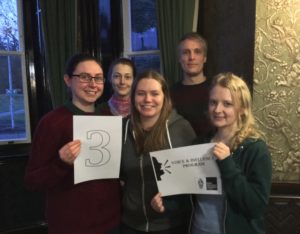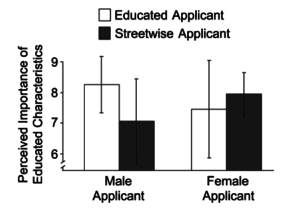Yesterday we held the third session of WISDOM’s edition of the Voice and Influence program. The topic was levelling the playing field, and we learned how to recognize and counteract stereotypes in order to reduce bias, i.e., to reduce errors when making decisions.
In the video we watched, Shelley Correll, a professor of sociology, listed six strategies to reduce bias. In this blog post, I’ll summarize her six strategies and talk about some of the studies she mentioned throughout the video.
1. Educate yourself and others about bias.
One easy action everyone can do to become more aware of their biases is take an implicit association test online here. Project Implicit was founded in 1998 with the goal of educating the public about hidden biases. Their website lets you test your implicit associations about topics such as gender, ethnicity, age, and sexuality.
Also, the School of Information Security and Mathematics has an upcoming unconscious bias training session for academic staff, support staff, and PhD students. It will be held next week, on Wednesday, 22 February from 13-17:00 in Windsor 1-05. Lunch will be provided. If you’d like to attend, send an RSVP to Lisa (lisa.cavey@rhul.ac.uk).
2. Establish clear criteria before making decisions.
One way that stereotypes can introduce errors in decision-making is by shifting criteria. Shelley talked about a 2005 study (whose results are presented in the article “Constructed Criteria: Redefining Merit to Justify Discrimination”) in which participants reviewed applications for stereotypically male or female jobs. The first experiment considered the stereotypically male job of police chief. There were four types of applicants: they were either (formally) educated or streetwise, and were either male or female. Participants were asked to indicated their hiring criteria (i.e., is being educated or streetwise more important?) and evaluate the application they received.
The following figure shows the results of this experiment: there was a significant difference in the importance of hiring criteria depending on whether the applicant was male or female. In other words, if the male applicant was educated, then being educated was deemed the most important hiring criterion; if the male applicant was streetwise, then being streetwise was deemed the most important hiring criterion.
The study also included a similar experiment for the traditionally female job of women’s studies professor. The results were analogous: whatever characteristic the female applicant satisfied was deemed to be the most important hiring criterion. Yet there is hope: the study concluded that “[c]ommitment to hiring criteria prior to disclosure of the applicant’s gender eliminated discrimination”.
3. Scrutinize the criteria being used.
Determining criteria for making a decision before starting to make it can reduce bias. But what if the criteria itself are biased?? Shelley talked about the success of Carnegie Mellon’s undergraduate computer science program: in 1995, just 7% of first year CS students were female, but 5 years later, 42% were female. In 2016, the percentage of female students was 48.5 . An entire book has been written about what was done to achieve this and why. One of the four main actions was removing the requirement that applicants already have programming experience—instead, applications were assessed for potential. The result was more female students and no change in the students’ success in the computer science program.
4. Hold decision-makers accountable.
If you’re making a decision, you should be able to explain why you made it.
Stereotypes can result in men and women being judged by different standards. Structured decision-making makes it harder for stereotypes to impede judgement.
Shelley mentioned a study from 1999 (whose results are presented in the article “The Impact of Gender on the Review of the Curricula Vitae of Job Applicants and Tenure Candidates: A National Empirical Study”) in which academic psychologists were sent a candidate’s CV and a questionnaire asking to evaluate the candidate. The study participants received one of four CVs: the name on it was either male (“Brian”) or female (“Karen”), and it represented either an early-career or mid-career academic psychologist.
The participants were more likely to deem the applicant as “hireable” if they received a CV with a male name on it, especially for the early-career applicant.
Whether they deemed the applicant as “tenurable” did not seem to be affected by the name on the CV. However, the mid-career female CV received four times as many “cautionary comments” as the identical male CV. The study’s authors hypothesized that perhaps this discrepancy was due to the early-career CV being much less “hireable” than the mid-career CV is “tenurable”. Finally, the study found no difference in how female and male academic psychologists rated the CVs.
5. Be transparent in progress toward goals. Post numbers and keep track of progress.
If you’ve read the message from Keith Mayes posted on the main page of WISDOM’s blog or on the WISDOM page on the ISG website, you’ll know that the proportion of female students in the ISG is “surprisingly consistent at 20%”.
6. Vouch for the competence of women, especially women leaders.
Why might it be more important to vouch for the competence of women than of men?
Research studies, including some of the ones mentioned above, find that men are often deemed more competent than equally qualified women. A 2015 study by VitalSmarts found that assertive women are judged much more harshly than assertive men.
In the video we watched, Shelley referred to a study from 1990, whose results are presented in the article “Legitimizing the Leader: Endorsement by Male Versus Female Authority Figures“. This study found that perceived leadership competence was higher when the leader was introduced and endorsed (or “legitimized”) by an authority figure, rather than just introduced by an authority figure. This increase in leadership competence occurred whether the authority figure was male or female. When the leader was male, both authority figures affected the evaluations just as much. When the leader was female, however, the female authority figure’s endorsement had a significantly greater impact on the leader’s evaluation.
More resources on bias:
The HASTAC (Humanities, Arts, Science, and Technology Alliance and Collaboratory) maintains a webpage with an annotated bibliography of recent studies on gender bias in academia.
Business Insider published an infographic of 20 cognitive biases. Stereotyping is just one of them.
The next Voice & Influence session at Royal Holloway will be Tuesday, 28 February at 16:00 in the Large Boardroom in Founders. All postgraduate students and staff in the School of Mathematics and Information Security are welcome to attend.

by Marie-Sarah Lacharite, PhD student.

